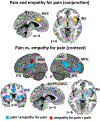Do I feel or do I know? Neuroimaging meta-analyses on the multiple facets of empathy
- PMID: 32562973
- PMCID: PMC7390692
- DOI: 10.1016/j.cortex.2020.04.031
Do I feel or do I know? Neuroimaging meta-analyses on the multiple facets of empathy
Abstract
Empathy is a multidimensional construct including affective and cognitive components while maintaining the distinction between one-self and others. Our meta-analyses focused on shared and distinct networks underlying cognitive (taking somebody else's perspective in emotional/painful situations) and affective (self-referentially feeling somebody else's emotions/pain) empathy for various states including painful and emotional situations. Furthermore, a comparison with direct pain experience was carried out. For cognitive empathy, consistent activation in the anterior dorsal medial frontal gyrus (dmPFG) and the supramarginal gyrus (SMG) occurred. For affective empathy, convergent activation of the posterior dmPFG and the inferior frontal gyrus (IFG) was found. Consistent activation of the anterior insula (AI), the anterior dmPFG and the SMG was observed for empathy for pain, while convergent recruitment of the temporo-parietal junction, precuneus, posterior dmPFG, and the IFG was revealed in the meta-analysis across empathy for emotion experiments. The AI and the dmPFG/mid-cingulate cortex (MCC) showed overlapping as well as distinct neural activation for pain processing and empathy for pain. Taken together, we were able to show difference in the meta-analytic networks across cognitive and affective empathy as well as for pain and empathy processing. Based on the current results, distinct functions along the midline structures of the brain during empathy processing are apparent. Our data are lending further support for a multidimensional concept of empathy.
Keywords: ACC/MCC/dmPFG; Cognitive and affective empathy; Emotions; Insula; Pain; TPJ.
Copyright © 2020 Elsevier Ltd. All rights reserved.
Conflict of interest statement
Financial Disclosure and conflict of interest
The authors report no biomedical financial interests or potential conflicts of interest in relation to the manuscript.
Figures





Similar articles
-
Neural dynamics between anterior insular cortex and right supramarginal gyrus dissociate genuine affect sharing from perceptual saliency of pretended pain.Elife. 2021 Aug 19;10:e69994. doi: 10.7554/eLife.69994. Elife. 2021. PMID: 34409940 Free PMC article.
-
Is Empathy for Pain Unique in Its Neural Correlates? A Meta-Analysis of Neuroimaging Studies of Empathy.Front Behav Neurosci. 2018 Nov 27;12:289. doi: 10.3389/fnbeh.2018.00289. eCollection 2018. Front Behav Neurosci. 2018. PMID: 30542272 Free PMC article.
-
Shared and distinct functional networks for empathy and pain processing: a systematic review and meta-analysis of fMRI studies.Soc Cogn Affect Neurosci. 2020 Sep 24;15(7):709-723. doi: 10.1093/scan/nsaa090. Soc Cogn Affect Neurosci. 2020. PMID: 32608498 Free PMC article.
-
A meta-analysis of neuroimaging studies on pain empathy: investigating the role of visual information and observers' perspective.Soc Cogn Affect Neurosci. 2019 Aug 31;14(8):789-813. doi: 10.1093/scan/nsz055. Soc Cogn Affect Neurosci. 2019. PMID: 31393982 Free PMC article.
-
Functional MRI examination of empathy for pain in people with schizophrenia reveals abnormal activation related to cognitive perspective-taking but typical activation linked to affective sharing.J Psychiatry Neurosci. 2017 Jun;42(4):262-272. doi: 10.1503/jpn.160136. J Psychiatry Neurosci. 2017. PMID: 28556774 Free PMC article.
Cited by
-
Audiovisual integration in the human brain: a coordinate-based meta-analysis.Cereb Cortex. 2023 Apr 25;33(9):5574-5584. doi: 10.1093/cercor/bhac443. Cereb Cortex. 2023. PMID: 36336347 Free PMC article.
-
Affective music during episodic memory recollection modulates subsequent false emotional memory traces: an fMRI study.Cogn Affect Behav Neurosci. 2024 Oct;24(5):912-930. doi: 10.3758/s13415-024-01200-0. Epub 2024 Jul 2. Cogn Affect Behav Neurosci. 2024. PMID: 38955872
-
Altruism under Stress: Cortisol Negatively Predicts Charitable Giving and Neural Value Representations Depending on Mentalizing Capacity.J Neurosci. 2022 Apr 20;42(16):3445-3460. doi: 10.1523/JNEUROSCI.1870-21.2022. Epub 2022 Mar 14. J Neurosci. 2022. PMID: 35288436 Free PMC article.
-
Reducing racial ingroup biases in empathy and altruistic decision-making by shifting racial identification.Sci Adv. 2025 Apr 25;11(17):eadt6207. doi: 10.1126/sciadv.adt6207. Epub 2025 Apr 23. Sci Adv. 2025. PMID: 40267185 Free PMC article.
-
Cumulative Dopaminergic Genetic Effects on Empathy Development in Emerging Adults.J Youth Adolesc. 2025 May 21. doi: 10.1007/s10964-025-02189-6. Online ahead of print. J Youth Adolesc. 2025. PMID: 40397252
References
Publication types
MeSH terms
Grants and funding
LinkOut - more resources
Full Text Sources

